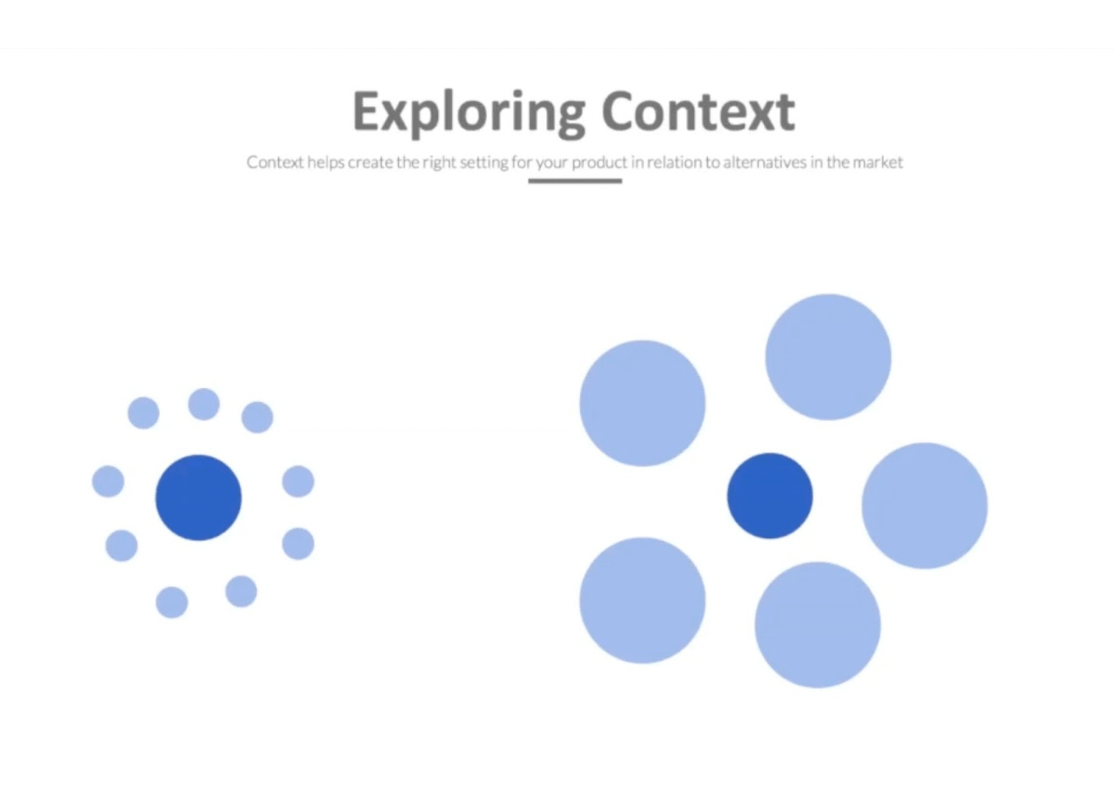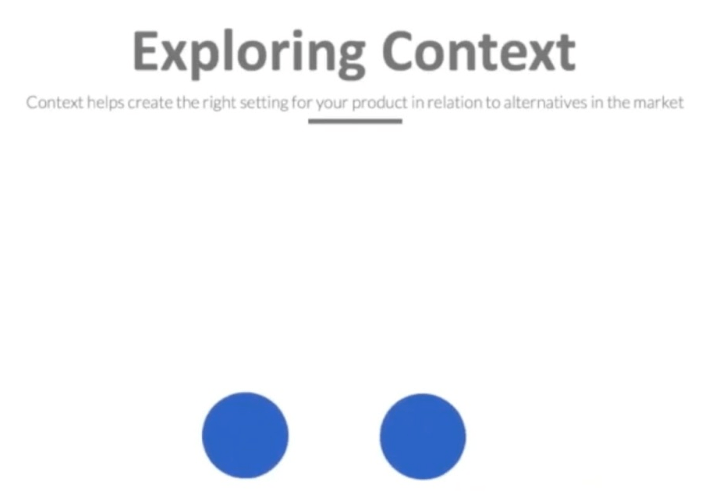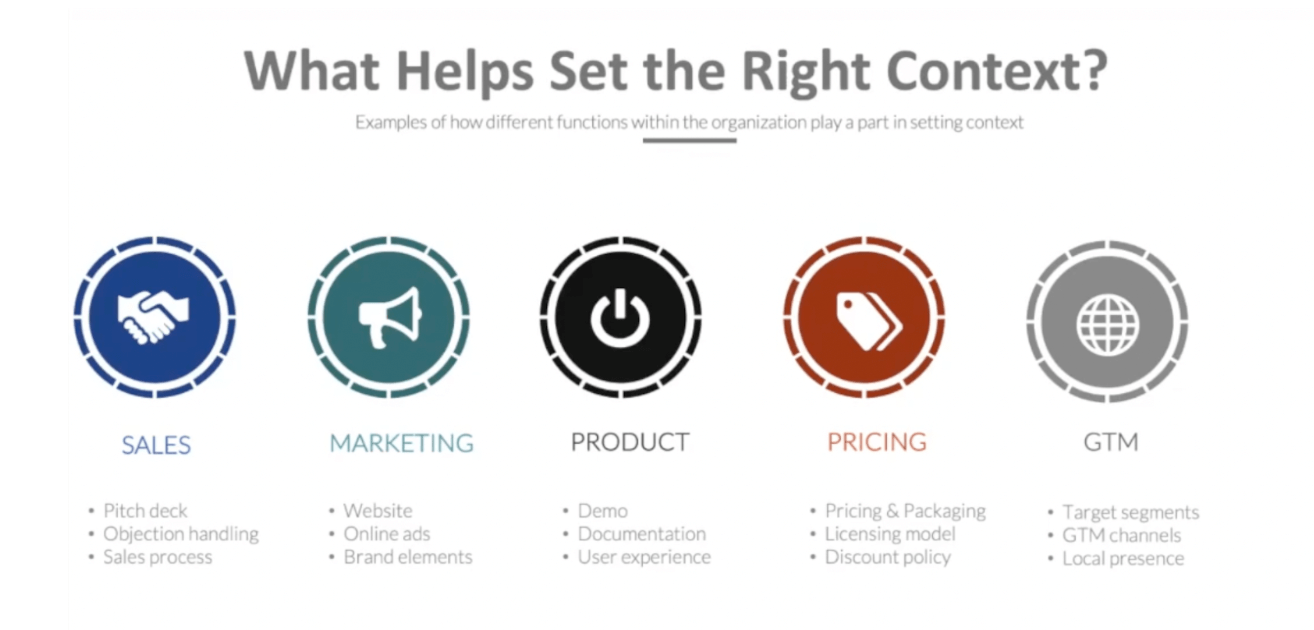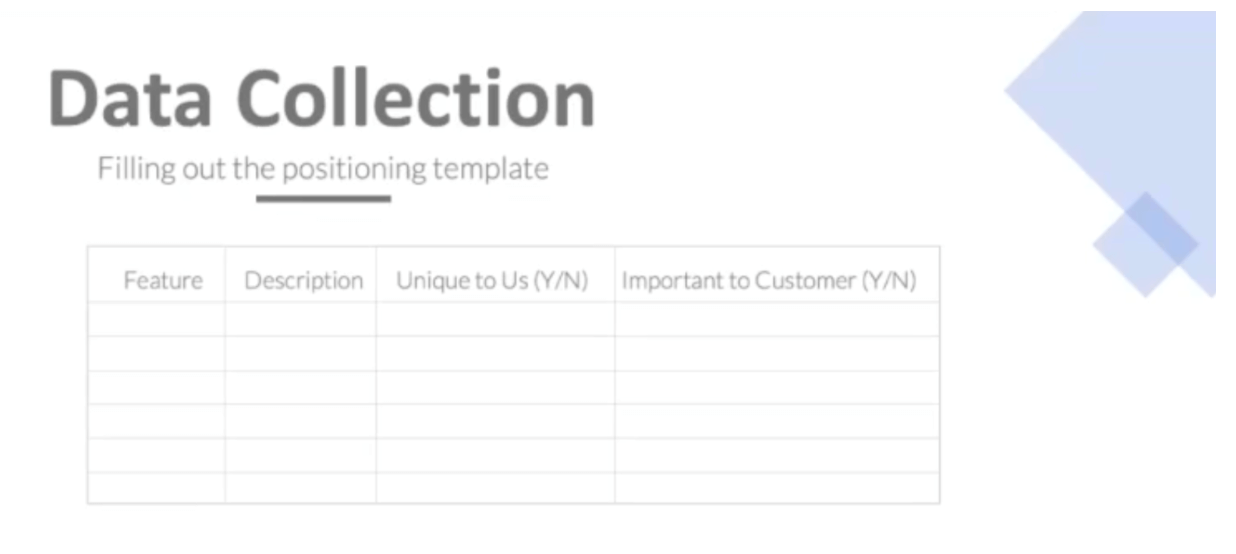Throughout this article, I'd like to provide you with some best practices and a process that you can adopt, adapt, and use in your own company the next time you're faced with the challenge of crafting positioning and messaging for the products that you sell.
In this article, I’ll be exploring:
- Product positioning
- Positioning templates
- Context
- Data collection
- The positioning process
- What messaging is, and why it’s important
- The messaging test
- Messaging deployment
What is product positioning?
Let’s start with positioning, which is all about where you want to play and where you choose not to play.
There’s no perfect positioning strategy, and once you’ve established one it shouldn’t be set in stone; you have to update and refresh it over time. It’s also worth noting that good positioning is also not a clear determining factor for success. However, poor positioning will certainly spell doom for your product.
Several key factors go into your positioning, including…
- The market
- Which market are you playing in?
- Is your solution entering an existing category or creating a new one?
- The competition
- Who are the key players?
- How similar are their capabilities?
- Do any of them have greater capabilities?
- How dynamic is the market?
These questions can be answered via the completion of thorough competitive intelligence.
The buyer
- Who buys your product and why?
- What challenges and needs do they have?
- What is their buying process?
- Will your future customers look like your existing ones?
Your differentiators
- What key product characteristics make you unique?
- Why do you win and why do you lose?
- What value does your company bring to the customer?
The positioning template
Now, we have all this information, what do we do with it? You want to start by using it to fill out a positioning template. [Note: You can download your own positioning template from your members dashboard.]
Why is a positioning template useful?
The first reason you should use a positioning template is to explore all the different possible directions you could take and then document and explain why you believe certain directions are better for your company than others.
The second reason is to ensure clarity on the direction that you're suggesting. You can clearly articulate the reasons for your choices, such as why you should go into healthcare and not financial services, or which buyers you should go for and which ones you should avoid.
The document also helps create alignment across different stakeholders like sales, support, and many others, so that they are able to participate in the positioning exercise and align on expected outcomes.
Finally, laying out all of this will help you see how to best set the context for your buyer and create a narrative that will help you position your product in the minds of your customer.
Exploring context
Let's take a quick detour here to talk a little bit more about that critical component I just mentioned: context.
In Predictably Irrational, Dan Ariely states that most people don't know what they want unless they see it in context. Below, you can see a good example from the book. The question is whether the dark blue circle on the left or the right is larger.

In fact, when we remove the light blue circles and show just the dark blue ones side by side, we can see that they’re the same size.
When we see circles surrounded by smaller or bigger ones, our brains trick us by changing how we interpret things. In other words, the context in which the circle is placed affects how we perceive it – the same applies to your product.

This is why it's wise to choose your market and your competitors carefully. When someone asks you who you compete with, the answer you give them will give them a frame of reference and immediately place you in either group A or group B.
Also, because we love comparing things that are easily comparable, if you're selling software to developers, for example, you should use examples that developers understand to set the context.
Similarly, if you're selling software for human resources, you want to set a familiar and easy-to-understand context. This is a core part of positioning. I’ll give you a couple of examples.
Many years ago, I worked at a startup in the sales enablement space. We were selling primarily to sales teams.
When we tried to expand our footprint and engage outside the sales team, for example with human resources leaders, we had to use a different context so that the HR people could understand.
We also had to be careful about how we set the context so we wouldn't be lumped in alongside all of the other HR software that they were used to buying.
We talked more about how our solution was a solution for employee enablement, not just sales enablement. This differentiated us from solutions like learning management systems and learning portals and enabled us to expand our footprint within the company.
I also like to use the example of a well-known company in the tech space called Gong.
They positioned themselves not as a product for call recording and transcription, but as a new way of getting intelligence out of sales calls – they called it conversational intelligence. This was an inspired way of harnessing context to create a whole new category.
What can help you set the right context?
The context isn’t just something you write in a document and forget. For the positioning you create to be effective, it needs to be reflected across multiple elements such as sales, marketing, product, pricing, and your overall go-to-market activity.

Much like when you go to an expensive restaurant, and you're expecting a certain quality of service, a certain ambience, a certain number of tables, lighting, etc, the same is true with the product you're selling and everything that goes around it.
Data collection
Let’s get back to the positioning document. To complete it with the right data, you’re going to use a series of inputs:
- Win/loss analysis
- Competitive research
- Analyst reports and inquiries
- Customer interviews
- Sales interviews
- Workshops with your sales, sales engineering, and marketing teams
I’m going to share a couple of data-collection exercises with you. The first exercise is the creation of a spreadsheet where you list out your core product features along with a quick description to ensure everyone understands which features you’re talking about.
Then, you ask the team, either individually or as a group, to answer “yes” or “no” alongside each feature to show which ones they believe are unique to your product in the market.
Next, hide that column and ask the team to identify which features they believe are most important to customers in terms of solving their major challenges or pain points. This'll lead to a rich discussion and list of important and unique features, which can then be sorted and grouped.

Another way to run this exercise is by creating post-it notes, either physically or virtually, listing your key capabilities and features. You can even include some different colored notes with capabilities that might be missing from your product today.
Then, ask people to rate each one as high, medium, or low in terms of importance to the customer. After that, ask them to rate which ones they believe to be key differentiators for your product capabilities in the market.
The outcome of these exercises is that you come up with a shortlist of unique product attributes that match your customer's most pressing needs. It’s also a great way to get alignment across teams by discussing what they believe to be important or not important to customers and unique to your product.
The positioning process
Now that you’ve collected all that data, it’s time to fill out the positioning document and share it with stakeholders across the organization. They could include sales leaders, others in your team, and business leaders in other areas.
This'll ensure that everyone gets a peek at what you’ve learned about your key positioning areas so that later on you won’t hear any questions about why you decided to spend marketing dollars on one segment, persona, or feature versus another.
This is also a great opportunity to get feedback from others and have them point out any possible gaps, which shows you are not creating this in isolation – you’re involving your cross-functional teams and customers.
After aligning your stakeholders, you can then proceed to the main outcome of this data collection and positioning exercise: the positioning statement. There are several ways to craft positioning statements. One classic structure includes the following elements:
- For [target]
- Who are [segment]
- The [product/brand]
- Provides the [category]
- With [difference]
- Because of [proof]
Whichever format you choose, the aim is to end up with a concise statement that clearly articulates where you play, for whom, and why you win.
Wait! Don’t do this…
Now, let me stop you right here. Before we go any further, I want to warn you about a mistake that I've seen over and over again: You create a great positioning statement, and you think you're done. Guess what? Your work is not yet done. Don’t go emailing people the statement or putting it on a website just yet.
The full process has one more element: the messaging. The positioning statement is just an internal document that you’ll use to guide the creation of your external messaging and everything else that goes along with it. It also helps align teams internally.
Can you use it externally? Sure you can, but this is not the only messaging that you're going to create. Having said that, let's jump into what messaging is.
What is messaging and why is it important?
In short, messaging is how you communicate your value proposition to your customers. Let’s dig into how you can do that and why it’s important.
Your messaging is going to help you expand on your positioning statement to articulate to your buyers why you're better than the alternatives. It also helps you to set the context we talked about earlier, putting you in the right category in the mind of the customer and supporting your key differentiators.
On top of all that, it helps your broader teams to articulate your story and key value proposition. This helps activate your positioning and gives guidance to the rest of the organization about where you play and how you win.
There are several messaging templates out there, but they typically contain a few key elements:
- Your positioning statement – The starting point of your narrative
- Short and long product descriptions – The narrative
- Key messaging/outcome pillars – Supporting narratives
1) Customer challenges or pain points
2) How your product solves those pain points
3) The value your product provides
- Proof points – Customer case studies, quotes, ROI reports, etc.
The messaging test
Now, as you craft your messaging, how do you know if it's any good? It's easy to get lost in industry terms, try to cover too much ground, or – on the opposite end – take an overly high-level view of your product.
To help you avoid these traps, here are some things to ask yourself and others as they help you with this exercise:
- Does our new messaging document convey who we are as a company and how we see the market?
- Is it speaking to a clearly defined audience? (Remember: if your product is for everyone, it’s for no one.)
- Are we demonstrating our understanding of our audience’s concerns?
- Is a tangible business problem or opportunity clearly laid out?
- Have we shown the cost of doing nothing?
- Is the path to a solution clear?
- Are our capabilities truly differentiated from the alternatives in the market?
Messaging deployment
Now that you’ve crafted a core message that the whole organization can rally around, let’s look at how you deploy it.
There are two important tasks as you deploy your messaging. First, there's messaging enablement, which is a series of activities that you're going to do internally to get all your teams aligned and trained on the “why” of your messaging and how to use it.
Second, there's messaging activation, which is all about customer-facing activities. In other words, it’s how you translate your messaging into marketing campaigns, website pages, product demos, and more.
Let’s wrap up
As you can see, there is a lot that goes into crafting an effective positioning and messaging strategy. I could go on and on, but I hope this article has given you food for thought and ideas for what to do next time you're tasked with updating your company’s messaging or creating it from scratch.



